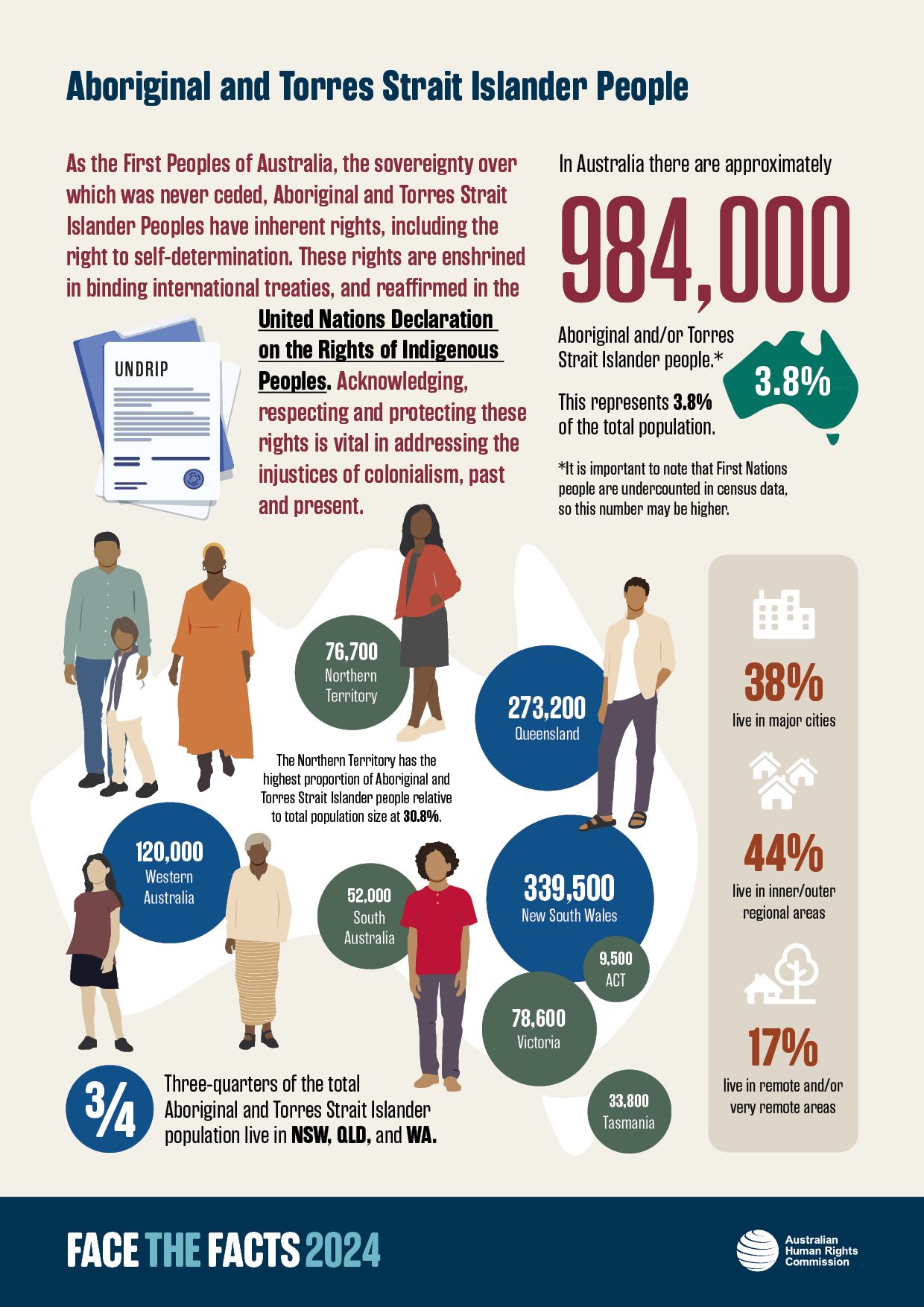Statistics about Aboriginal and Torres Strait Islander People
02/07/2025
As the First Peoples of Australia, the sovereignty over which was never ceded, Aboriginal and Torres Strait Islander Peoples have inherent rights, including the right to self-determination. These rights are enshrined in binding international treaties, and reaffirmed in the United Nations Declaration on the Rights of Indigenous Peoples. Acknowledging, respecting and protecting these rights is vital in addressing the injustices of colonialism, past and present.
In Australia there are approximately 984,000 Aboriginal and/or Torres Strait Islander people. This represents 3.8% of the total Australian population.[1] It is important to note that First Nations people are undercounted in census data, so this number may be higher.[2]
Where Aboriginal and Torres Strait Islander peoples live
- States and territories – almost three-quarters (3/4) of the total Aboriginal and Torres Strait Islander population live in NSW, QLD, and WA
- 339,500 people – New South Wales
- 273,200 people – Queensland
- 120,000 people – Western Australia
- 78,600 – Victoria
- 52,000 – South Australia
- 33,800 – Tasmania
- 9,500 – Australian Capital Territory
- 76,700 – Northern Territory[3]
- The Northern Territory has the highest proportion of Aboriginal and Torres Strait Islander people relative to total population size (30.8%).[4]
- Area
- 38% live in Major cities
- 44% live in Inner and outer regional areas
- 17% live in Remote and very remote areas combined.[5]
Country & Connection
Aboriginal and Torres Strait Islander people maintain strong connections to culture, language, and traditional lands, and contribute significantly to the environmental management, economic development, and cultural identity of Australia.
Of Aboriginal and Torres Strait Islander peoples:
- 74% recognise an area as a homeland or traditional country
- this was 91% in remote areas
- and 71% in non-remote areas.[6]
- 24% live on their homeland
- this was 43% in remote areas
- and 20% in non-remote areas[7]
Language
- At the time of European colonisation, there were at least 250 distinct Aboriginal and Torres Strait Islander languages spoken across the continent.
- Approximately 123 of these languages are in use today
- 12 of these being spoken fluently by all generations within a community.[8]
- The number of Aboriginal and/or Torres Strait Islander language speakers is on the rise. 76,978 Indigenous people reported speaking an Aboriginal or Torres Strait Islander language in 2021, up from 63,754 in 2016.[9]
The ongoing colonisation of Australia has negatively affected many Aboriginal and Torres Strait Islander people and communities. This is important to note when considering experiences of disadvantage, discrimination, and hardship.
Education & Employment & Adequate standard of living
- 40% live without two or more essentials for a decent standard of living, such as housing, clean water, and food. This is in comparison to 11% of other people born in Australia.[10]
- The median weekly household income of First Nations peoples is 28% less than that of non-Indigenous peoples.
- This gap stretches to 50% in remote areas.[11]
- 57% aged 20 years and over have a year 12 certificate or higher qualification.[12]
- Make up 0.7% of senior leadership across Australian employers.[13]
- 15% aged 15 and over provide unpaid assistance to a person with a disability.
- Indigenous women (18%) are more likely to provide unpaid care, than Indigenous men (12%).[14]
- Indigenous women (18%) are more likely to provide unpaid care, than Indigenous men (12%).[14]
References
- [1] ‘Estimates of Aboriginal and Torres Strait Islander Australians,’ Australian Bureau of Statistics (Web page, 21 September 2021).
- [2] Ingeborg van Teeseling, 'The Census and Indigenous People: Undercounted and Underserviced’, Australia Explained (Web page, 10 August 2021).
- [3] Ingeborg van Teeseling, 'The Census and Indigenous People: Undercounted and Underserviced’, Australia Explained (Web page, 10 August 2021).
- [4] Ingeborg van Teeseling, 'The Census and Indigenous People: Undercounted and Underserviced’, Australia Explained (Web page, 10 August 2021).
- [5] ‘Profile of Indigenous Australians’, Australian Institute of Health and Welfare (Web page, 7 September 2023).
- [6] ‘Profile of Indigenous Australians’, Australian Institute of Health and Welfare (Web page, 7 September 2023).
- [7] ‘Profile of Indigenous Australians’, Australian Institute of Health and Welfare (Web page, 7 September 2023).
- [8] Department of Infrastructure, Transport, Regional Development and Communications (Cth) Australian Institute of Aboriginal and Torres Strait Islander Studies and Australian National University, National Indigenous Languages Report (Web page, Report, 2020) 8.
- [9] ‘Language Statistics for Aboriginal and Torres Strait Islander Peoples’, Australian Bureau of Statistics (Web page, 25 October 2022).
- [10] Productivity Commission, Rising Inequality? A Stocktake of the Evidence (Research Paper, August 2018).
- [11] Australian Institute of Health and Welfare, Income (Web page, 2024). NB: Statistics refer to median gross weekly equivalised income.
- [12] ‘Education Statistics for Aboriginal and Torres Strait Islander Peoples’, Australian Bureau of Statistics (Web page, 4 December 2020).
- [13] Minderoo Foundation, Indigenous Employment Index, (Report, 2022).
- [14] Australian Institute of Health and Welfare, 'Health status and outcomes: 1.14 Disability’, Aboriginal and Torres Strait Islander Health Performance Framework (Web page).; ‘Specialised support and informal care for First Nations people with disability’, Australian Institute of Health and Welfare (Web page, 7 September 2023).


